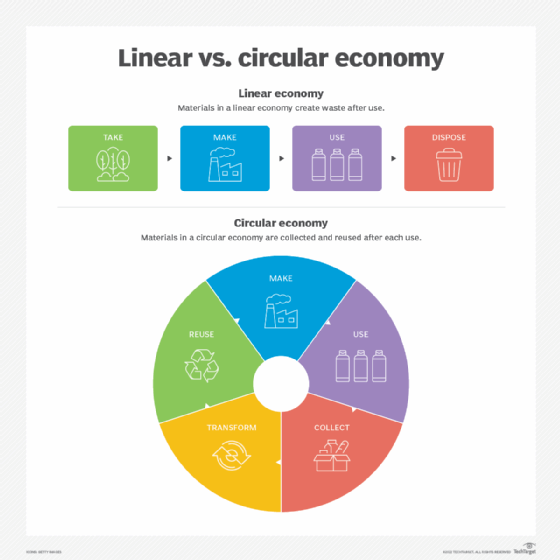
Use the data center circular economy for sustainability
Building data center servers and hardware requires use of many of Earth's nonrenewable resources. Data center owners must adopt the circular economy system for sustainability.
As described by the Ellen MacArthur Foundation, one of the top international organizations promoting circular-economic thinking today, the circular economy is a system that keeps products and materials in circulation through processes like reuse, refurbishment and recycling. The goal behind this system is to sustainably support more natural processes and reduce waste production.
Data centers are known to harm the environment, particularly regarding energy usage and electronic waste (e-waste). By using the principles of the circular economy, data centers can build more sustainable operations. When used in concert with other green data center techniques and best practices, the data center circular economy could greatly reduce the industry's global impact on the environment.
How does a circular economy work?
Three principles are at the core of how a circular economy works: eliminate waste and pollution, circulate products and materials, and regenerate nature.
Eliminate waste and pollution
In a linear economy, materials are taken from the earth, used to create products and eventually thrown away. This produces waste, which often ends up in landfills or incinerators. A circular economy aims to remove as much waste as possible from production. This ranges from creating products that have no packaging to using technology that eliminates waste in manufacturing.
Circulate products and materials
Materials are used for as long as possible in a circular economy. For example, instead of throwing away networking equipment that is no longer in use, break it down into its components to better other products. Naturally recycle materials that are not reusable through practices like composting.

Regenerate nature
This principle focuses on embracing a regenerative model. Instead of taking from nature, aim to build naturally healing systems. For example, regenerative farming practices avoid taking all the nutrients and cultivate biodiversity and soil health from the land. Clean energy is an example of this as it moves away from fossil fuel use and toward renewable energy sources.
The practice to regenerate nature can reduce pollution and build more sustainable systems for production. When these principles are embedded into the economy, the result is a circular ecosystem that produces less waste, keeps materials in use for longer and helps the planet thrive.
How to adopt a circular economy model in the data center
Here are a few ways data centers can begin to participate in a circular economy and cultivate more sustainable practices.
Provide access to education and establish policies and workflows
Shifting to a circular economy requires a brand-new approach to design. As such, data center owners can educate employees about circular-economic principles and share resources.
Once you educate the data center staff, it's time to create circular protocols and processes that they can understand and follow. This helps ensure adoption and compliance.
Minimize mining of raw materials
According to a paper in the Circular Economy and Sustainability journal, 23 of the world's 30 critical raw materials that are vital to the global economy and have no substitutes are found in server, storage and networking equipment. Data centers should minimize the mining of these materials by reusing existing resources instead. Whenever possible, opt for remanufactured, refurbished or used equipment.
Transition to renewable energy
Moving away from fossil fuels is critical to reducing greenhouse gas emissions and decarbonization. As such, data centers need to transition to clean energy by switching to power grids supported by hydroelectric, wind or solar energy.
Reuse heat and water
The heat generated by data centers often funnels back into the atmosphere, but there are creative ways to redirect that heat. For example, some data centers are rerouting it to heat local facilities, like community swimming pools. Water consumption for liquid cooling can also be curbed through similar efforts, like natural cooling.
Conduct lifecycle assessments
Lifecycle assessments involve evaluating the net environmental impact of the production process. For the data center, this includes energy usage, pollution, building construction and management, along with any other activity associated with material use. These assessments are key to measuring sustainability.
Improve the longevity of equipment
Predictive maintenance can help avoid downtime and keep equipment active for longer. Keep the technology alive longer by selling obsolete IT equipment.
When equipment is not reusable, clear the data, and dismantle the hardware into individual components for reuse. If the quality of components is too poor, follow proper procedures to recycle them.
Digital technologies can assist with the circular management of e-waste. Data centers can partner with waste collection companies that collect and treat e-waste to ensure appropriate sorting and disposal.
Adopt newer digital technologies
The following digital technologies can make production more environmentally efficient:
- Machine learning (ML) and AI can process materials more efficiently.
- Blockchain technology can enhance circular production procedures and measure environmental impact.
- 3D printing can design products without having to use raw materials from the earth.
- Smart apps, sensors and robots can perform more sophisticated collection, sorting and recycling of e-waste.
Partner with values-aligned vendors
A circular economy cannot be built alone. It requires multiple partners working together to maximize resources and products. Data centers must join with other data centers, vendors, communities and independent organizations partaking in circular-economic initiatives.
Real-world data center circular economy practices
Some organizations, like Microsoft, Amazon and Google, are getting creative about how they participate in a circular economy.
Microsoft
Microsoft aims to reuse 90% of its cloud computing hardware assets by 2025. The company launched three Circular Centers to achieve its goal. These centers process decommissioned cloud servers and hardware components to reuse or repurpose.
The pilot Circular Center based in Amsterdam has achieved 83% reuse and 17% recycle of critical parts. These achievements contribute to the goal of reducing carbon emissions by 145,000 metric tons of carbon dioxide equivalent. This Circular Center was established in 2020, and the circular design enabled Microsoft to react faster to supply chain shortages impacted by the COVID-19 pandemic by using harvested parts with components from end-of-life assets.
Microsoft has incorporated circular philosophies into the Azure hardware design process, using AI and ML to process and sort end-of-life assets, optimize routes and provide clear instructions on how to safely dispose of them.
These centers also help decommissioned servers find new homes in schools for IT skill training programs, repurpose used memory cards for gaming systems and evaluate old network devices for maximum reuse with suppliers.
Amazon
AWS has established several reverse logistics hubs. These facilities take in hardware from local data centers. The hardware is either fixed or demanufactured to reuse components in other data center hardware.
This is a multistep process. First, decommissioned server racks are collected and sanitized of data and then the racks are demanufactured into individual components. Each component is then evaluated to determine the highest reuse potential, such as power supply units, GPUs or switches. Then, they are refurbished, repaired and tested to ensure functionality. Once this process is complete, the components reenter inventory for reuse in AWS data centers.
As of 2022, seven of Google's 23 data centers have achieved their zero-waste goals, which maximizes the reuse of products and materials as much as possible and diverts 90% or more of solid waste from landfills. According to Google's annual environmental reports, 32.6 million hardware components have been resold into the secondary market since 2015, and 27% of upgrade components were from refurbished inventory in 2021.
Google's European data center in Fredericia, Denmark, has achieved zero waste to landfill from day one. It works with a waste collection and separation partner to recycle additional material.
Jacob Roundy is a freelance writer and editor, specializing in a variety of technology topics, including data centers and sustainability.







